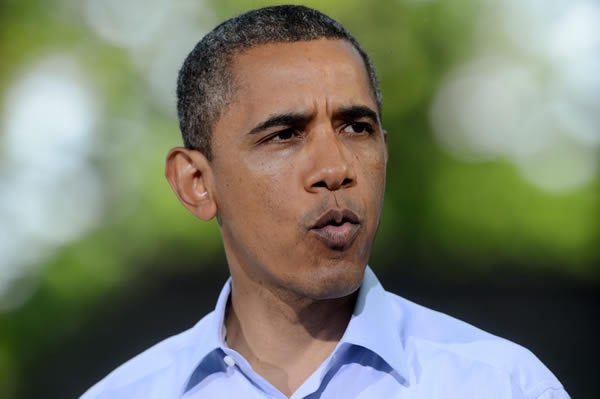Spending has skyrocketed under President Obama, but of late some are claiming that the opposite is true. Case in point: MarketWatch columnist Rex Nutting wrote, “Obama spending binge never happened,” and Politifact rated this statement “mostly true.”
But Mitt Romney this week said that “Since President Obama assumed office three years ago, federal spending has accelrated at a pace without precedent in recent history.” So who has it right? Mitt Romney.
What Politifact must have missed is a very important data point: President Obama signed most of the spending attributed to President George W. Bush’s last year in office, which was assigned wrongly to Bush in Nutting’s piece. (Heritage’s Emily Goff and Alison Fraser set the record straight on The Foundry.)
Nutting argues that President G.W. Bush’s second term spending bills from Fiscal Year 2006-2009 averaged 8.1% and President Obama’s annualized growth averaged 1.4%. The reason why Nutting included FY 2009 is because it was “the last of George W. Bush’s presidency — federal spending rose by 17.9% from $2.98 trillion to $3.52 trillion.” This assumption is incorrect and dishonest. This flaw in Nutting’s analysis is the reason why the Obama numbers are wrong and Nutting’s whole piece is based on flawed data.
Nutting operates under the flawed assumption that President Obama is not responsible for FY 2009 spending. Under normal circumstances Nutting would be correct. If Congress were a functioning body that passed appropriations bills on time, then this analysis would be correct. The fact of the matter is that in recent history Congress has not done appropriations bills on time and in FY 2009, President Obama signed these spending bills into law that President Bush would have under different circumstances.
Usually, the president in office prior to a new president would have helped craft and sign into law government spending bills applied to the first 9 months of spending the next year and a president’s new term. A fiscal year starts on October 1 of the year prior to the calendar year to September 30th of the calendar year. In other words the fiscal year starts three months early.
In FY2009, Congress did not complete work by September 30, 2008. President Bush did sign some appropriations bills and a continuing resolution to keep the government running into President Obama’s first term, yet a Democrat controlled Congress purposely held off on the big spending portions of the appropriations bills until Obama took office. They did so for the purposes of jacking up spending. President Obama signed the final FY2009 spending bills on March 11, 2009.
Congressional Quarterly (subscription required) maps out a history of the FY 2009 final appropriations bills (H.R. 1105 and PL 111-8), that would lead one to attribute most of the accelerated spending in FY 2009 to President Obama in a piece titled “2009 Legislative Summary: Fiscal 2009 Omnibus.” From CQ, “the omnibus provided a total of $1.05 trillion — $410 billion of it for discretionary programs — and included many of the domestic spending increases Democrats were unable to get enacted while George W. Bush was president.” If accepted as true, this statement alone undercuts Nutting’s whole premise that FY 2009 is wholly Bush spending.
President Bush signed only three of the twelve appropriations bills for FY 2009: Defense; Military Construction/Veterans Affairs; and, Homeland Security. President Bush also signed a continuing resolution that kept the government running until March 6, 2009 that level of funding the remaining nine appropriations bills at FY 2008 levels. President Bush and his spending should only be judged on these three appropriations bills and FY 2008 levels of funding for the remaining nine appropriations bills. Bush never consented to the dramatic increase in spending for FY 2009 and he should not be blamed for that spending spree.
The Democrats purposely held off on the appropriations process because they hoped they could come into 2009 with a new Democrat-friendly Congress and a President who would sign bloated spending bills. Remember, President Obama was in the Senate when these bills were crafted and he was part of this process to craft bloated spending bills. CQ reported that “in delaying the nine remaining bills until 2009, Democrats gambled that they would come out of the November 2008 elections with bigger majorities in both chambers and a Democrat in the White House who would support more funding for domestic programs.” And they did.
If you trust CQ’s reporting, and I do, then this is damning. Democrats in Congress purposely held off on pushing bloated appropriations bills because they knew President Bush would not sign the bill and Republicans in the Senate would block consideration of it. You have to remember that the Senate went from 51-49 Democrat control under President Bush’s last year to 59-41 in the early days of President Obama. On April 28, 2009, Senator Arlen Specter switched parties from Republican to Democrat to give the Democrats a 60 vote filibuster proof majority in the Senate. The House had a similar conversion from a 233-202 Democrat majority to 257-178 Democrat majority. Democrats were banking on a big enough majorities in the Senate and House that they could pass the bloated spending bill and they got it.
Bush issued a veto threat on the bloated spending bills pending in Congress in late 2008. CQ estimated that the final spending bill “provided about $31 billion more in discretionary funding than was included in the fiscal 2008 versions of the nine bills” which is “about $19 billion more than Bush sought.” I would argue that Obama gets credit for the whole $31 billion in new spending. The most damning fact from the CQ piece is that “Bush had threatened to veto spending bills that exceeded his request.”
Now one can argue that even $31 billion is a drop in the bucket when one considers that spending went from $2.98 trillion to $3.52 trillion. Much of the spike in increased spending is on the mandatory spending side, and much of it can be attributed to President Obama. Look at OMB Tables on FY 2008 spending versus FY 2009 spending and you can see why the numbers spiked between those two years.
Overall spending, mandatory and discretionary spending went from $2.98 trillion in FY 2008 to $3.52 trillion in FY 2009. There were two of the big spikes in spending from FY’08 to ’09. One was in Federal Payments for Individuals not including Social Security and Medicare from $758 billion in FY’08 to 918 billion in FY’09. President Obama’s Stimulus spending bill included an increase in food stamps and an extension of unemployment benefits that should not be attributable to President Bush. Also, the category of “Other Federal” spending spiked from $261 billion to $540 billion. This includes TARP spending that was recovered on the back end by President Obama further distorting the Nutting analysis.
So how can Nutting attribute spending to President Bush that he expressly vowed to veto? Also, some of the mandatory spending has been wrongly attributed to President Bush in Nutting’s analysis. Finally, TARP spending under Bush and the recovery of TARP money under Obama further distorts these numbers.
This is unethical and fuzzy math. The Truth-O-Meter may want to consider these facts when further analyzing the complications and distortions in analysis used by Nutting to argue that Obama is more fiscally responsible than his predecessors.
































50 Replies to “The Truth about President Obama’s Skyrocketing Spending”